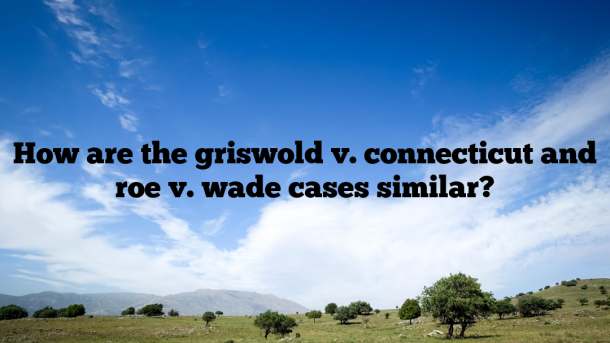How are the griswold v. connecticut and roe v. wade cases similar?
In the annals of constitutional law, certain cases emerge as pivotal moments that reshape the legal landscape and societal norms. Griswold v. Connecticut and Roe v. Wade are two such landmark cases that, though distinct in their contexts, share parallel paths in challenging restrictive state laws and advancing constitutional protections. This exploration revisits these cases, tracing their trajectories and uncovering the common threads that bind Griswold and Roe in the tapestry of constitutional jurisprudence.
Griswold v. Connecticut: Challenging Marital Privacy Restrictions
Antecedents of Griswold
Griswold v. Connecticut, decided in 1965, was rooted in the Connecticut Comstock Act of 1879, which criminalized the use of contraceptives. Estelle Griswold, the executive director of Planned Parenthood League of Connecticut, and Dr. C. Lee Buxton, a physician and professor at Yale Medical School, challenged this law. The case presented a constitutional challenge to restrictions on the use of contraceptives, even for married couples.
Landmark Decision: Marital Privacy
The Supreme Court, led by Justice William O. Douglas, delivered a landmark decision recognizing a right to marital privacy. While the Constitution did not explicitly mention privacy, Justice Douglas argued that various amendments, particularly the First, Third, Fourth, Fifth, and Ninth, created zones of privacy. Griswold, therefore, laid the foundation for recognizing implied constitutional rights and set the stage for later cases, including Roe v. Wade.
Roe v. Wade: The Right to Choose in Reproductive Matters
Antecedents of Roe
Roe v. Wade, decided in 1973, stemmed from a Texas law criminalizing most abortions except to save the life of the mother. Norma McCorvey, under the pseudonym “Jane Roe,” challenged the constitutionality of this statute. The case reached the Supreme Court, presenting a momentous opportunity to reevaluate the state’s role in regulating a woman’s reproductive choices.
Landmark Decision: Expanding Reproductive Rights
In a historic decision, the Supreme Court, with Justice Harry Blackmun writing the majority opinion, recognized a woman’s right to choose to have an abortion as part of her constitutional right to privacy. The decision divided pregnancy into three trimesters, with different levels of state interest and regulation permitted in each. Roe marked a watershed moment in affirming a woman’s autonomy over her reproductive decisions, echoing the themes of individual privacy established in Griswold.
Parallel Narratives: Challenging Restrictive Laws
Restrictions on Personal Choices
Griswold and Roe share parallel narratives in challenging state laws that sought to regulate deeply personal and private aspects of individuals’ lives. Griswold confronted a law limiting access to contraceptives, while Roe challenged restrictive abortion laws. In both instances, the state sought to intrude into private decisions within the realms of marriage and reproductive health, prompting the Supreme Court to assess the constitutionality of such interference.
Evolution in Legal Argumentation
The legal arguments in Griswold and Roe followed parallel paths, emphasizing the concept of privacy as a fundamental right implicit in the Constitution. In Griswold, the right to marital privacy was derived from various amendments, and in Roe, this right expanded to include a woman’s autonomy over her reproductive choices. The parallel evolution in legal argumentation showcased a growing recognition of the Constitution’s protection of individual autonomy against intrusive state action.
Judicial Activism and Social Change: A Common Theme
Judicial Activism in Griswold
Griswold and Roe are emblematic of judicial activism, where the Court takes an assertive role in interpreting the Constitution to align with evolving societal norms. Griswold challenged traditional notions about privacy within marriage, with the Court engaging in a robust interpretation of constitutional principles. This judicial activism set the stage for Roe, where the Court continued to play a bold role in expanding constitutional protections to reproductive choices.
Social Impact and Backlash
Both cases triggered social impact and backlash, illustrating the profound influence of judicial decisions on societal norms. Griswold faced opposition rooted in traditional values that questioned the legitimacy of a judicially implied right to privacy. Similarly, Roe ignited a protracted debate on the morality and legality of abortion, generating a social movement that persists to this day. The social impact and backlash underscore the complex interplay between legal decisions and societal values.
Guardians of Individual Rights: Defending Privacy and Autonomy
Establishing the Judiciary as Guardians
Griswold and Roe cast the judiciary as guardians of individual rights, particularly the rights to privacy and autonomy. Griswold established a precedent for the Court to play a proactive role in protecting personal decisions from undue government interference. Roe, building upon this foundation, further solidified the judiciary’s position as a defender of individual liberties against laws that sought to infringe upon private choices.
Legal Framework: Due Process and Fundamental Rights
The legal framework connecting Griswold and Roe is anchored in the Due Process Clause of the Fourteenth Amendment. Griswold argued that Connecticut’s prohibition on contraceptives violated the right to marital privacy protected by the Due Process Clause. Roe extended this reasoning to reproductive choices, asserting that a state law restricting access to abortion interfered with a woman’s fundamental right to privacy and personal autonomy.
Evolution of Reproductive Rights: A Continuum from Griswold to Roe
Griswold’s Legacy in Roe
Griswold’s legacy is palpable in Roe v. Wade, as the recognition of privacy rights within the context of marriage laid the groundwork for the broader expansion of reproductive rights. The concept of privacy, first articulated in Griswold, evolved from marital privacy to encompass personal autonomy in reproductive decisions. Griswold’s imprint on Roe underscores the intergenerational impact of legal precedents.
Challenges and Advances
The journey from Griswold to Roe reflects societal progress but also highlights ongoing challenges. While both cases affirmed fundamental rights, the struggle for reproductive rights continues. Griswold and Roe are integral chapters in an ongoing narrative, emphasizing the need for vigilance in protecting and expanding individual liberties. The legal continuum from Griswold to Roe represents an evolving understanding of the Constitution’s role in safeguarding personal choices.
Conclusion: Revisiting Landmarks in Constitutional Jurisprudence
Enduring Legacy and Ongoing Challenges
Revisiting Griswold and Roe unveils a rich tapestry of constitutional jurisprudence. The parallel paths of these landmark cases, challenging restrictive laws and advancing constitutional protections, exemplify the judiciary’s role as a guardian of individual rights. Griswold’s legacy in Roe and the enduring impact of both cases underscore the dynamic nature of constitutional interpretation and its profound influence on societal norms. As guardians of individual liberties, Griswold and Roe continue to inspire ongoing discussions about privacy, autonomy, and the ever-evolving landscape of constitutional law.



